Pumping Station Desing - Second Edition by Robert L. Sanks, George Tchobahoglous, Garr M. Jones
Подождите немного. Документ загружается.

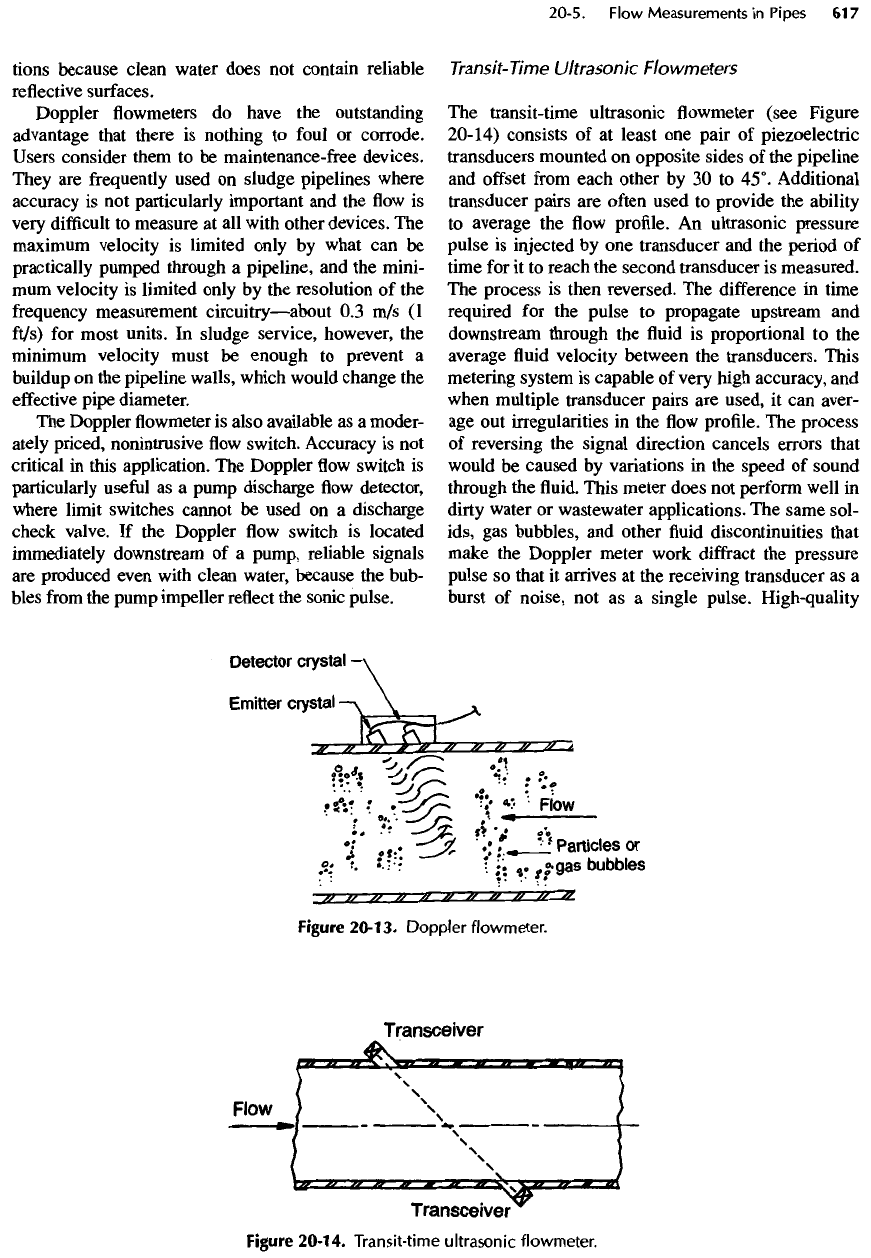
tions because clean water does
not
contain
reliable
reflective
surfaces.
Doppler
flowmeters do
have
the
outstanding
advantage
that there
is
nothing
to
foul
or
corrode.
Users
consider
them
to be
maintenance-free
devices.
They
are
frequently
used
on
sludge pipelines where
accuracy
is not
particularly important
and the flow is
very
difficult
to
measure
at all
with other devices.
The
maximum
velocity
is
limited only
by
what
can be
practically pumped through
a
pipeline,
and the
mini-
mum
velocity
is
limited only
by the
resolution
of the
frequency
measurement
circuitry—about
0.3 m/s (1
ft/s)
for
most units.
In
sludge service, however,
the
minimum
velocity must
be
enough
to
prevent
a
buildup
on the
pipeline walls, which would change
the
effective
pipe
diameter.
The
Doppler
flowmeter is
also available
as a
moder-
ately
priced,
nonintrusive
flow
switch. Accuracy
is not
critical
in
this application.
The
Doppler
flow
switch
is
particularly
useful
as a
pump discharge
flow
detector,
where
limit switches cannot
be
used
on a
discharge
check valve.
If the
Doppler
flow
switch
is
located
immediately downstream
of a
pump, reliable signals
are
produced even with clean water, because
the
bub-
bles
from
the
pump impeller
reflect
the
sonic pulse.
Transit-Time
Ultrasonic
Flowmeters
The
transit-time ultrasonic
flowmeter
(see Figure
20-14)
consists
of at
least
one
pair
of
piezoelectric
transducers mounted
on
opposite
sides
of the
pipeline
and
offset
from
each other
by 30 to
45°. Additional
transducer pairs
are
often
used
to
provide
the
ability
to
average
the flow
profile.
An
ultrasonic pressure
pulse
is
injected
by one
transducer
and the
period
of
time
for it to
reach
the
second transducer
is
measured.
The
process
is
then reversed.
The
difference
in
time
required
for the
pulse
to
propagate upstream
and
downstream through
the fluid is
proportional
to the
average
fluid
velocity between
the
transducers. This
metering system
is
capable
of
very high accuracy,
and
when
multiple
transducer pairs
are
used,
it can
aver-
age out
irregularities
in the flow
profile.
The
process
of
reversing
the
signal direction cancels errors that
would
be
caused
by
variations
in the
speed
of
sound
through
the fluid.
This meter
does
not
perform well
in
dirty water
or
wastewater applications.
The
same sol-
ids,
gas
bubbles,
and
other
fluid
discontinuities that
make
the
Doppler meter work
diffract
the
pressure
pulse
so
that
it
arrives
at the
receiving transducer
as a
burst
of
noise,
not as a
single pulse. High-quality
Figure
20-14.
Transit-time
ultrasonic
flowmeter.
Figure
20-13.
Doppler
flowmeter.

electronics
can
deal with
the
noise
to a
certain extent,
but
they increase
the
cost
of the
meter substantially.
The
transit-time ultrasonic
flowmeter is
especially
useful
on
very large pipes where cost becomes less
of
a
factor.
The
maximum velocity
is
limited only
by
what
can be
pumped through
a
given size pipe,
and
the
minimum velocity
is
limited
by the
resolution
of
the
timing
circuits—
0.3
m/s
(1
ft/s).
Propeller
Meters
As
its
name implies,
a
propeller meter contains
a
pro-
peller installed coaxially
in the
center
of the
pipe,
as
shown
in
Figure
20-15.
Flow turns
the
propeller
at a
speed proportional
to the
liquid velocity.
It is a
low-
cost device used primarily
in
clean water applications
where
it
gives excellent service. Depending
on the
manufacturer
and the
meter size,
the
mechanical
nature
of the
equipment limits
the
usable
flow
range
to
about
0.15
to 3.0 m/s
(0.5
to 10
ft/s).
Its
only disad-
vantage
(for clean water service)
is the
need
to
replace
bearings
from
time
to
time.
Turbine
Meters
Turbine
flowmeters
have many blades
on a
rotor whose
speed
is a
linear
function
of fluid flow
velocity within
an
error
of
about ±0.5% over
a
very wide
flow
range
of
10
or
even 20:1.
The
blades
are
vulnerable
to
particu-
late
matter,
so the
meter
is
used only
for
clean water.
Vortex
Flowmeters
In
vortex
flowmeters, a
transverse,
flat bar
(called
a
"bluff
body") across
the
pipe splits
the flow
into
two
paths
and
causes vortices
to
shed alternately
from
the
sides
of the bar at a
frequency that
is (1)
linearly pro-
portional
to
velocity
and (2)
independent
of fluid
den-
sity
over
flow
ranges
up to
30:1.
The
meters
can be
used
for
liquids, gases,
and
cryogenic
fluids.
There
are
no
moving parts,
and the
construction allows sand
in
dirty
water
to
pass without obstruction.
The
shedding
rate
for
vortices
is
linear above
a
Reynolds number
of
10,000.
The
meters
are
available
in
sizes
from
38 to
400 mm
(1.5
to 16
in.),
and
their
use in
chemical
and
industrial
fields is
increasing because
of
their accu-
racy (which
is
slightly greater than
the
accuracy
of a
Venturi
meter), range,
and
insensitivity
to fluid
prop-
erties. These excellent characteristics
are no
less
applicable
to the
measurement
of
water.
Summary
For
clean water applications,
the
propeller meter
is a
good choice
for all
sizes
of
pipes.
For
sewage,
the
Venturi
meter
is
widely used even though keeping
the
pressure ports clean
is
troublesome. Venturi meters
for
pipes
larger than
600 mm (24
in.) become compara-
tively
costly
and
require straight-approach pipes that
may
be
inconveniently long. Install
a
freshwater purge
system
and a
pipe configuration that allows
the
Ven-
turi
meter
to be
removed
for
cleaning.
The
magnetic
meter
is
much preferred
by
many experts because
of
its
superior accuracy
and
reliability, although mainte-
nance
is
still
a
problem. Both Venturi
and
magnetic
meters
are
heavy
in
sizes larger than
300 mm
(12
in.),
so
hoisting beams should
be
installed overhead. Con-
sider
the
Doppler meter
for
measuring
the flow of
sludge.
The
accuracy
of
Doppler meters
is not
good
(but
usually adequate), maintenance
is
negligible,
and
operators like them. Except
for raw
wastewater ser-
vice, consider
the
vortex meter.
20-6. Open
Channel
Flow
Measurement
Weirs
and flumes are
used
for
open channel
flow
mea-
surement. Weirs
are
applicable only
to
clean water
and
Figure
20-15.
Propeller
meter.
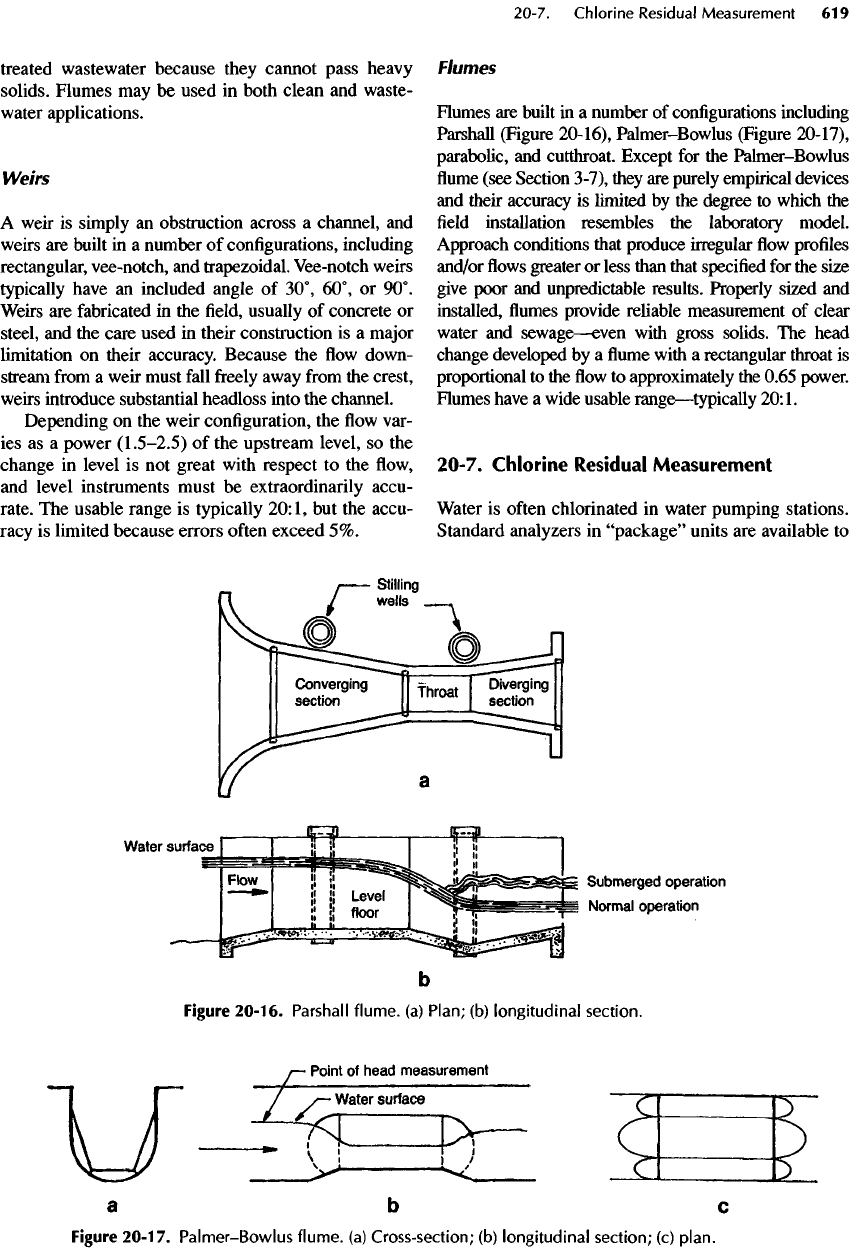
treated wastewater because they cannot pass heavy
solids.
Flumes
may be
used
in
both clean
and
waste-
water
applications.
Weirs
A
weir
is
simply
an
obstruction across
a
channel,
and
weirs
are
built
in a
number
of
configurations,
including
rectangular,
vee-notch,
and
trapezoidal. Vee-notch weirs
typically
have
an
included angle
of
30°, 60°,
or
90°.
Weirs
are
fabricated
in the field,
usually
of
concrete
or
steel,
and the
care used
in
their construction
is a
major
limitation
on
their accuracy. Because
the flow
down-
stream
from
a
weir must
fall
freely
away
from
the
crest,
weirs introduce substantial headloss into
the
channel.
Depending
on the
weir configuration,
the flow
var-
ies as a
power
(1.5-2.5)
of the
upstream level,
so the
change
in
level
is not
great with respect
to the flow,
and
level instruments must
be
extraordinarily accu-
rate.
The
usable range
is
typically
20:1,
but the
accu-
racy
is
limited because errors
often
exceed
5%.
Flumes
Flumes
are
built
in a
number
of
configurations
including
Parshall
(Figure 20-16), Palmer-Bowlus (Figure 20-17),
parabolic,
and
cutthroat. Except
for the
Palmer-Bowlus
flume
(see Section 3-7), they
are
purely empirical devices
and
their accuracy
is
limited
by the
degree
to
which
the
field
installation
resembles
the
laboratory model.
Approach
conditions that produce irregular
flow
profiles
and/or
flows
greater
or
less than
that
specified
for the
size
give
poor
and
unpredictable results. Properly sized
and
installed,
flumes
provide reliable measurement
of
clear
water
and
sewage
—
even
with gross
solids.
The
head
change developed
by a flume
with
a
rectangular throat
is
proportional
to the flow to
approximately
the
0.65 power.
Flumes have
a
wide usable
range
—
typically
20:1.
20-7.
Chlorine
Residual
Measurement
Water
is
often
chlorinated
in
water pumping stations.
Standard analyzers
in
"package"
units
are
available
to
Figure
20-16.
Parshall
flume,
(a)
Plan;
(b)
longitudinal
section.
Figure
20-17.
Palmer-Bowlus
flume,
(a)
Cross-section;
(b)
longitudinal
section;
(c)
plan.
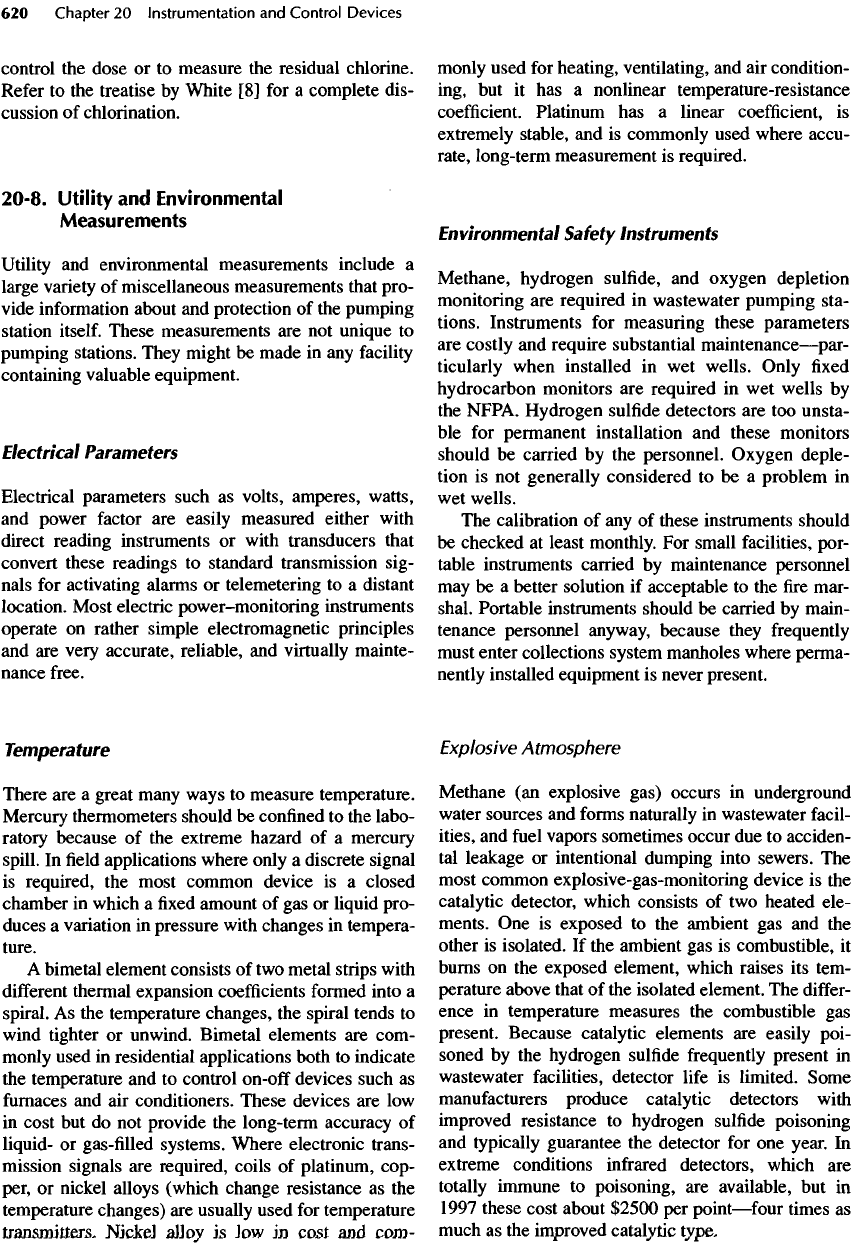
control
the
dose
or to
measure
the
residual
chlorine.
Refer
to the
treatise
by
White
[8] for a
complete dis-
cussion
of
chlorination.
20-8. Utility
and
Environmental
Measurements
Utility
and
environmental measurements include
a
large
variety
of
miscellaneous measurements that pro-
vide information about
and
protection
of the
pumping
station
itself. These measurements
are not
unique
to
pumping
stations. They might
be
made
in any
facility
containing
valuable equipment.
Electrical
Parameters
Electrical parameters such
as
volts, amperes, watts,
and
power
factor
are
easily measured either with
direct reading instruments
or
with transducers that
convert
these readings
to
standard transmission sig-
nals
for
activating alarms
or
telemetering
to a
distant
location. Most electric power-monitoring instruments
operate
on
rather simple electromagnetic principles
and
are
very accurate, reliable,
and
virtually mainte-
nance
free.
Temperature
There
are a
great
many
ways
to
measure temperature.
Mercury
thermometers should
be
confined
to the
labo-
ratory
because
of the
extreme hazard
of a
mercury
spill.
In field
applications where only
a
discrete
signal
is
required,
the
most common device
is a
closed
chamber
in
which
a fixed
amount
of gas or
liquid pro-
duces
a
variation
in
pressure with changes
in
tempera-
ture.
A
bimetal element consists
of two
metal strips with
different
thermal expansion
coefficients
formed into
a
spiral.
As the
temperature changes,
the
spiral tends
to
wind
tighter
or
unwind. Bimetal elements
are
com-
monly
used
in
residential applications both
to
indicate
the
temperature
and to
control
on-off
devices such
as
furnaces
and air
conditioners. These devices
are low
in
cost
but do not
provide
the
long-term accuracy
of
liquid-
or
gas-filled
systems. Where electronic trans-
mission signals
are
required, coils
of
platinum, cop-
per,
or
nickel alloys (which change
resistance
as the
temperature
changes)
are
usually used
for
temperature
transmitters.
Nickel
alloy
is
Jow
Ju
cost
and
com-
monly used
for
heating, ventilating,
and air
condition-
ing,
but it has a
nonlinear temperature-resistance
coefficient.
Platinum
has a
linear
coefficient,
is
extremely
stable,
and is
commonly used where accu-
rate, long-term measurement
is
required.
Environmental
Safety
Instruments
Methane, hydrogen
sulfide,
and
oxygen depletion
monitoring
are
required
in
wastewater pumping sta-
tions. Instruments
for
measuring these parameters
are
costly
and
require substantial
maintenance
—
par-
ticularly when installed
in wet
wells. Only
fixed
hydrocarbon monitors
are
required
in wet
wells
by
the
NFPA. Hydrogen
sulfide
detectors
are too
unsta-
ble for
permanent installation
and
these monitors
should
be
carried
by the
personnel. Oxygen deple-
tion
is not
generally considered
to be a
problem
in
wet
wells.
The
calibration
of any of
these instruments should
be
checked
at
least monthly.
For
small facilities, por-
table instruments carried
by
maintenance personnel
may
be a
better
solution
if
acceptable
to the fire
mar-
shal. Portable instruments should
be
carried
by
main-
tenance personnel anyway, because they
frequently
must
enter collections system manholes where perma-
nently installed equipment
is
never present.
Explosive
Atmosphere
Methane
(an
explosive gas) occurs
in
underground
water
sources
and
forms
naturally
in
wastewater facil-
ities,
and
fuel
vapors sometimes occur
due to
acciden-
tal
leakage
or
intentional dumping into sewers.
The
most
common
explosive-gas-monitoring
device
is the
catalytic detector, which consists
of two
heated ele-
ments.
One is
exposed
to the
ambient
gas and the
other
is
isolated.
If the
ambient
gas is
combustible,
it
burns
on the
exposed element, which raises
its
tem-
perature above that
of the
isolated element.
The
differ-
ence
in
temperature measures
the
combustible
gas
present. Because catalytic elements
are
easily poi-
soned
by the
hydrogen
sulfide
frequently
present
in
wastewater
facilities, detector
life
is
limited. Some
manufacturers
produce catalytic detectors with
improved resistance
to
hydrogen
sulfide
poisoning
and
typically guarantee
the
detector
for one
year.
In
extreme conditions
infrared
detectors, which
are
totally
immune
to
poisoning,
are
available,
but in
1997 these cost about
$2500
per
point
—
f
our
times
as
much
as the
improved catalytic
type.
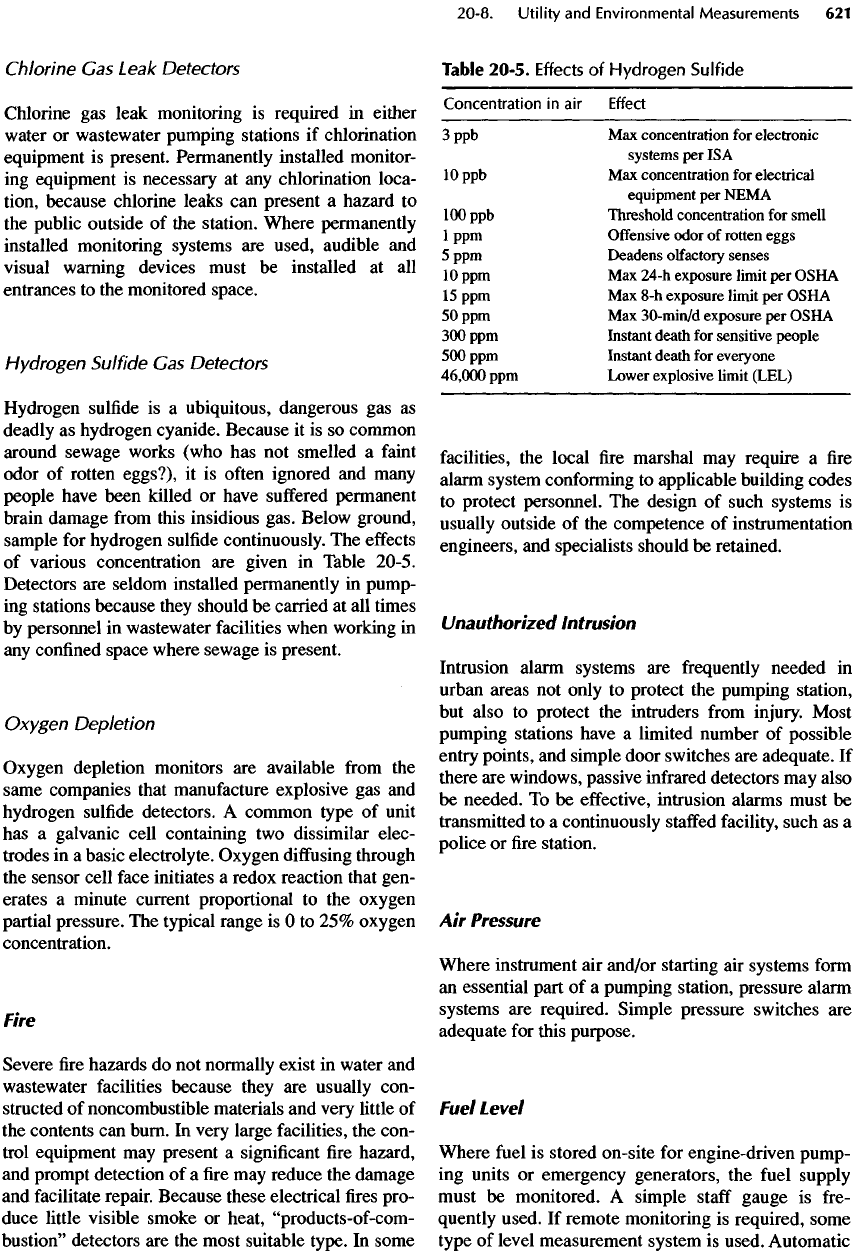
Chlorine
Gas
Leak Detectors
Chlorine
gas
leak monitoring
is
required
in
either
water
or
wastewater pumping stations
if
chlorination
equipment
is
present. Permanently installed monitor-
ing
equipment
is
necessary
at any
chlorination loca-
tion, because chlorine leaks
can
present
a
hazard
to
the
public outside
of the
station. Where permanently
installed monitoring systems
are
used, audible
and
visual
warning devices must
be
installed
at all
entrances
to the
monitored space.
Hydrogen
SuI
fide
Gas
Detectors
Hydrogen
sulfide
is a
ubiquitous, dangerous
gas as
deadly
as
hydrogen cyanide. Because
it is so
common
around
sewage works (who
has not
smelled
a
faint
odor
of
rotten
eggs?),
it is
often
ignored
and
many
people have been killed
or
have
suffered
permanent
brain
damage
from
this insidious gas. Below ground,
sample
for
hydrogen
sulfide
continuously.
The
effects
of
various concentration
are
given
in
Table 20-5.
Detectors
are
seldom installed permanently
in
pump-
ing
stations because they should
be
carried
at all
times
by
personnel
in
wastewater facilities when working
in
any
confined
space where sewage
is
present.
Oxygen Depletion
Oxygen
depletion monitors
are
available
from
the
same
companies that
manufacture
explosive
gas and
hydrogen
sulfide
detectors.
A
common type
of
unit
has
a
galvanic cell containing
two
dissimilar elec-
trodes
in a
basic electrolyte. Oxygen
diffusing
through
the
sensor cell
face
initiates
a
redox reaction that gen-
erates
a
minute current proportional
to the
oxygen
partial pressure.
The
typical range
is O to 25%
oxygen
concentration.
Fire
Severe
fire
hazards
do not
normally exist
in
water
and
wastewater
facilities because they
are
usually con-
structed
of
noncombustible materials
and
very little
of
the
contents
can
burn.
In
very large facilities,
the
con-
trol
equipment
may
present
a
significant
fire
hazard,
and
prompt detection
of a fire may
reduce
the
damage
and
facilitate repair. Because these electrical
fires
pro-
duce
little visible smoke
or
heat,
"products-of-com-
bustion"
detectors
are the
most suitable type.
In
some
Table
20-5.
Effects
of
Hydrogen
Sulfide
Concentration
in air
Effect
3 ppb Max
concentration
for
electronic
systems
per ISA
10
ppb Max
concentration
for
electrical
equipment
per
NEMA
100 ppb
Threshold concentration
for
smell
1 ppm
Offensive
odor
of
rotten eggs
5 ppm
Deadens olfactory senses
10
ppm Max
24-h exposure limit
per
OSHA
15
ppm Max 8-h
exposure limit
per
OSHA
50 ppm Max
30-min/d
exposure
per
OSHA
300 ppm
Instant death
for
sensitive people
500 ppm
Instant death
for
everyone
46,000
ppm
Lower explosive limit (LEL)
facilities,
the
local
fire
marshal
may
require
a fire
alarm
system conforming
to
applicable building codes
to
protect personnel.
The
design
of
such systems
is
usually
outside
of the
competence
of
instrumentation
engineers,
and
specialists should
be
retained.
Unauthorized
Intrusion
Intrusion alarm systems
are
frequently needed
in
urban
areas
not
only
to
protect
the
pumping station,
but
also
to
protect
the
intruders
from
injury.
Most
pumping
stations have
a
limited number
of
possible
entry
points,
and
simple door switches
are
adequate.
If
there
are
windows, passive infrared detectors
may
also
be
needed.
To be
effective,
intrusion alarms must
be
transmitted
to a
continuously
staffed
facility, such
as a
police
or fire
station.
Air
Pressure
Where instrument
air
and/or starting
air
systems
form
an
essential part
of a
pumping station, pressure alarm
systems
are
required. Simple pressure switches
are
adequate
for
this purpose.
Fuel
Level
Where
fuel
is
stored on-site
for
engine-driven pump-
ing
units
or
emergency generators,
the
fuel
supply
must
be
monitored.
A
simple
staff
gauge
is
fre-
quently
used.
If
remote monitoring
is
required, some
type
of
level measurement system
is
used. Automatic
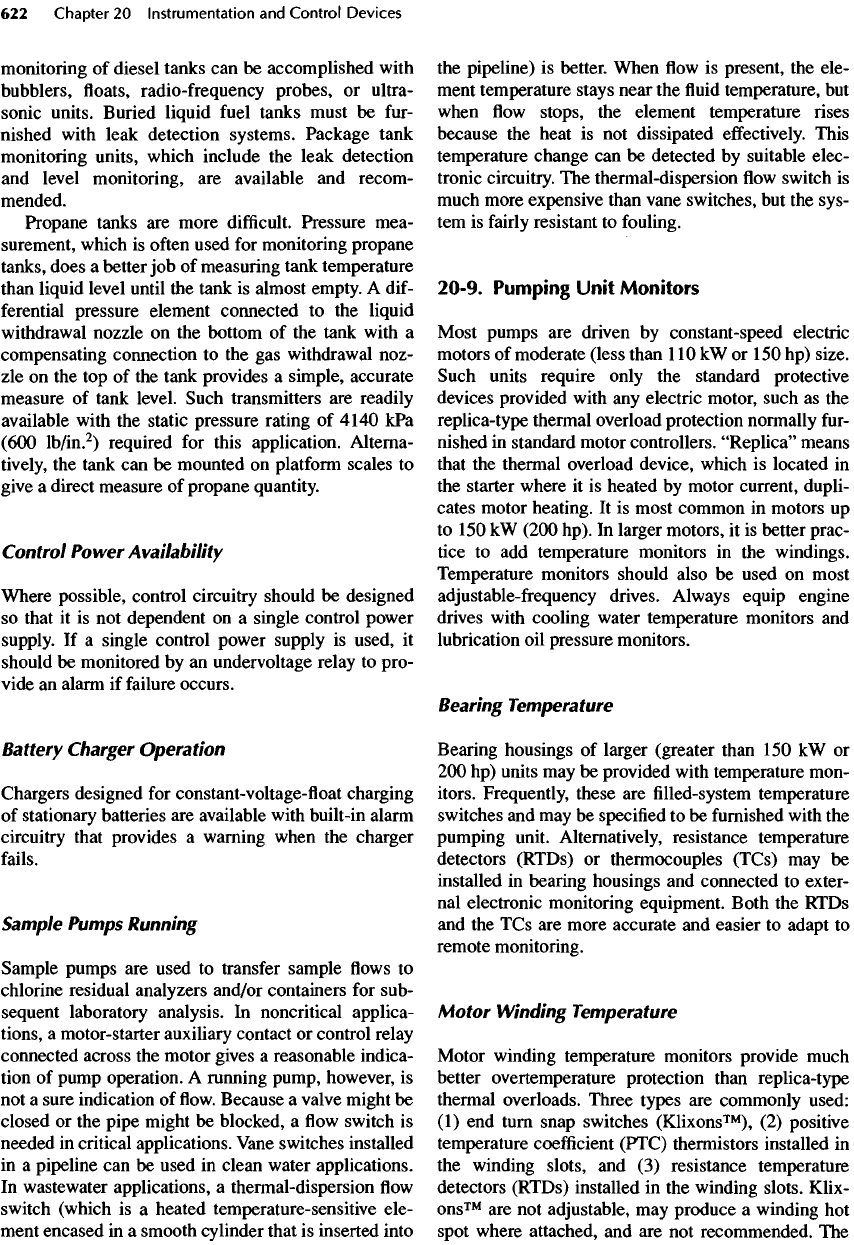
monitoring
of
diesel tanks
can be
accomplished with
bubblers,
floats,
radio-frequency
probes,
or
ultra-
sonic units. Buried liquid
fuel
tanks must
be
fur-
nished with leak detection systems. Package tank
monitoring units, which include
the
leak detection
and
level monitoring,
are
available
and
recom-
mended.
Propane tanks
are
more
difficult.
Pressure mea-
surement,
which
is
often
used
for
monitoring propane
tanks,
does
a
better
job of
measuring tank temperature
than
liquid level until
the
tank
is
almost empty.
A
dif-
ferential
pressure element connected
to the
liquid
withdrawal
nozzle
on the
bottom
of the
tank with
a
compensating connection
to the gas
withdrawal noz-
zle on the top of the
tank provides
a
simple, accurate
measure
of
tank level. Such transmitters
are
readily
available with
the
static pressure rating
of
4140
kPa
(600
lb/in.
2
)
required
for
this application. Alterna-
tively,
the
tank
can be
mounted
on
platform scales
to
give
a
direct measure
of
propane quantity.
Control Power Availability
Where possible, control circuitry should
be
designed
so
that
it is not
dependent
on a
single control power
supply.
If a
single control power supply
is
used,
it
should
be
monitored
by an
undervoltage
relay
to
pro-
vide
an
alarm
if
failure
occurs.
Battery
Charger Operation
Chargers designed
for
constant-voltage-float charging
of
stationary batteries
are
available with built-in alarm
circuitry
that provides
a
warning when
the
charger
fails.
Sample Pumps Running
Sample pumps
are
used
to
transfer sample
flows to
chlorine residual analyzers and/or containers
for
sub-
sequent laboratory analysis.
In
noncritical applica-
tions,
a
motor-starter auxiliary contact
or
control relay
connected across
the
motor gives
a
reasonable indica-
tion
of
pump operation.
A
running pump, however,
is
not
a
sure indication
of flow.
Because
a
valve might
be
closed
or the
pipe might
be
blocked,
a flow
switch
is
needed
in
critical applications.
Vane
switches installed
in
a
pipeline
can be
used
in
clean water applications.
In
wastewater applications,
a
thermal-dispersion
flow
switch
(which
is a
heated temperature-sensitive ele-
ment encased
in a
smooth cylinder that
is
inserted into
the
pipeline)
is
better. When
flow is
present,
the
ele-
ment
temperature stays near
the fluid
temperature,
but
when
flow
stops,
the
element temperature
rises
because
the
heat
is not
dissipated
effectively.
This
temperature change
can be
detected
by
suitable
elec-
tronic circuitry.
The
thermal-dispersion
flow
switch
is
much
more expensive than vane switches,
but the
sys-
tem is
fairly
resistant
to
fouling.
20-9. Pumping
Unit
Monitors
Most pumps
are
driven
by
constant-speed electric
motors
of
moderate
(less
than
1
10
kW or 150 hp)
size.
Such
units require only
the
standard protective
devices provided with
any
electric motor, such
as the
replica-type thermal overload protection normally fur-
nished
in
standard motor controllers.
"Replica"
means
that
the
thermal overload device, which
is
located
in
the
starter where
it is
heated
by
motor current, dupli-
cates motor heating.
It is
most common
in
motors
up
to 150 kW
(200 hp).
In
larger motors,
it is
better
prac-
tice
to add
temperature monitors
in the
windings.
Temperature monitors should also
be
used
on
most
adjustable-frequency
drives. Always equip engine
drives with cooling water temperature monitors
and
lubrication
oil
pressure monitors.
Bearing Temperature
Bearing housings
of
larger (greater than
150 kW or
200 hp)
units
may be
provided with temperature mon-
itors. Frequently, these
are filled-system
temperature
switches
and may be
specified
to be
furnished with
the
pumping
unit. Alternatively, resistance temperature
detectors (RTDs)
or
thermocouples (TCs)
may be
installed
in
bearing housings
and
connected
to
exter-
nal
electronic monitoring equipment. Both
the
RTDs
and
the TCs are
more accurate
and
easier
to
adapt
to
remote monitoring.
Motor Winding Temperature
Motor winding temperature monitors provide much
better
overtemperature
protection than replica-type
thermal overloads. Three types
are
commonly used:
(1) end
turn
snap switches
(Klixons™),
(2)
positive
temperature
coefficient
(PTC) thermistors installed
in
the
winding slots,
and (3)
resistance temperature
detectors (RTDs) installed
in the
winding slots. Klix-
ons™
are not
adjustable,
may
produce
a
winding
hot
spot where attached,
and are not
recommended.
The
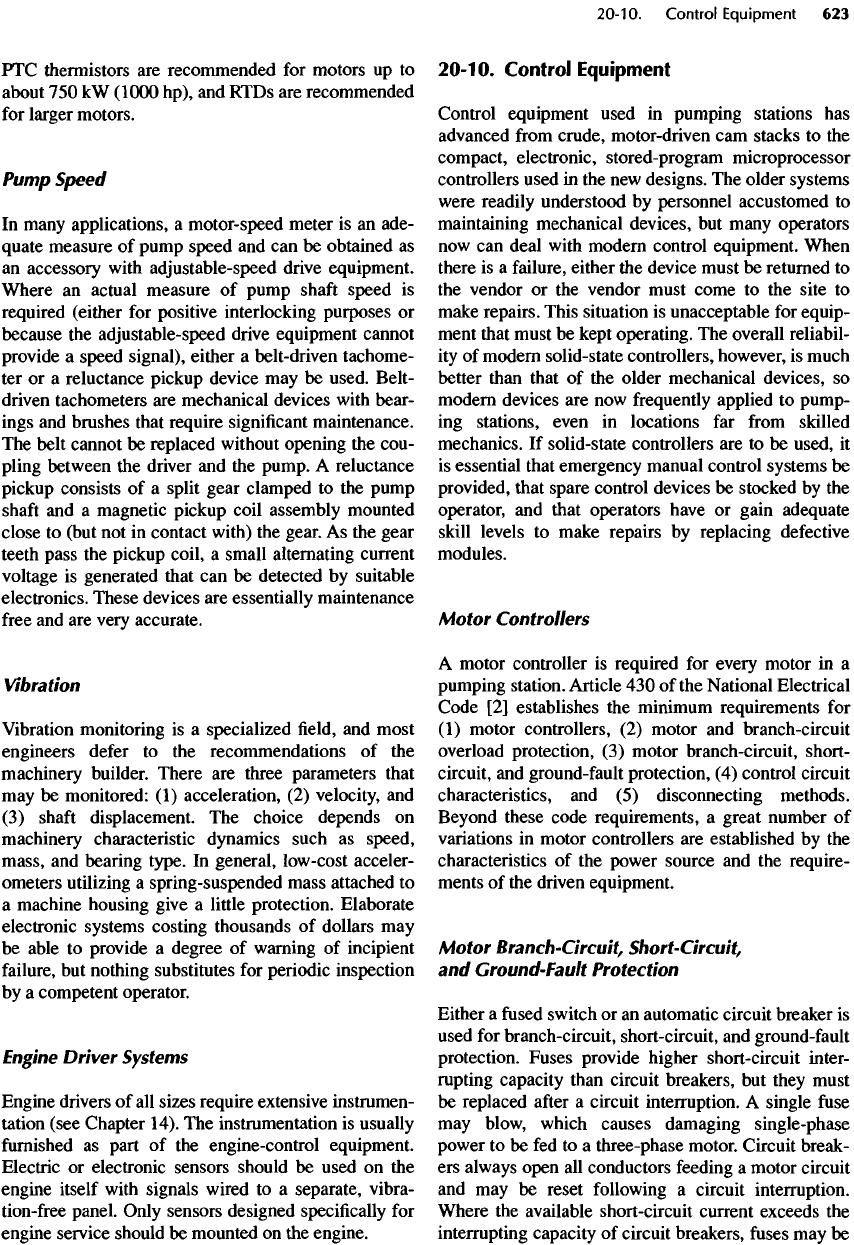
PTC
thermistors
are
recommended
for
motors
up to
about
750 kW
(1000 hp),
and
RTDs
are
recommended
for
larger motors.
Pump Speed
In
many applications,
a
motor-speed meter
is an
ade-
quate
measure
of
pump speed
and can be
obtained
as
an
accessory with adjustable-speed drive equipment.
Where
an
actual measure
of
pump
shaft
speed
is
required (either
for
positive interlocking purposes
or
because
the
adjustable-speed drive equipment cannot
provide
a
speed signal), either
a
belt-driven tachome-
ter or a
reluctance pickup device
may be
used. Belt-
driven
tachometers
are
mechanical devices with bear-
ings
and
brushes that require
significant
maintenance.
The
belt cannot
be
replaced without opening
the
cou-
pling between
the
driver
and the
pump.
A
reluctance
pickup
consists
of a
split gear clamped
to the
pump
shaft
and a
magnetic pickup coil assembly mounted
close
to
(but
not in
contact with)
the
gear.
As the
gear
teeth
pass
the
pickup coil,
a
small alternating current
voltage
is
generated that
can be
detected
by
suitable
electronics. These devices
are
essentially maintenance
free
and are
very accurate.
Vibration
Vibration
monitoring
is a
specialized
field, and
most
engineers
defer
to the
recommendations
of the
machinery
builder. There
are
three parameters that
may
be
monitored:
(1)
acceleration,
(2)
velocity,
and
(3)
shaft
displacement.
The
choice depends
on
machinery
characteristic dynamics such
as
speed,
mass,
and
bearing type.
In
general, low-cost acceler-
ometers utilizing
a
spring-suspended mass attached
to
a
machine housing give
a
little protection. Elaborate
electronic systems costing thousands
of
dollars
may
be
able
to
provide
a
degree
of
warning
of
incipient
failure,
but
nothing substitutes
for
periodic inspection
by
a
competent operator.
Engine
Driver Systems
Engine
drivers
of all
sizes require extensive instrumen-
tation
(see Chapter 14).
The
instrumentation
is
usually
furnished
as
part
of the
engine-control equipment.
Electric
or
electronic sensors should
be
used
on the
engine itself with signals wired
to a
separate, vibra-
tion-free
panel. Only sensors designed specifically
for
engine service should
be
mounted
on the
engine.
20-10.
Control
Equipment
Control equipment used
in
pumping stations
has
advanced
from
crude, motor-driven
cam
stacks
to the
compact, electronic,
stored-program
microprocessor
controllers used
in the new
designs.
The
older systems
were readily understood
by
personnel accustomed
to
maintaining mechanical devices,
but
many operators
now
can
deal with modern control equipment. When
there
is a
failure,
either
the
device must
be
returned
to
the
vendor
or the
vendor must come
to the
site
to
make
repairs. This situation
is
unacceptable
for
equip-
ment
that must
be
kept operating.
The
overall reliabil-
ity
of
modern solid-state controllers, however,
is
much
better than that
of the
older mechanical devices,
so
modern
devices
are now
frequently
applied
to
pump-
ing
stations, even
in
locations
far
from
skilled
mechanics.
If
solid-state controllers
are to be
used,
it
is
essential
that emergency manual control systems
be
provided, that spare control devices
be
stocked
by the
operator,
and
that operators have
or
gain adequate
skill levels
to
make repairs
by
replacing defective
modules.
Motor Controllers
A
motor controller
is
required
for
every motor
in a
pumping
station. Article
430 of the
National Electrical
Code
[2]
establishes
the
minimum requirements
for
(1)
motor controllers,
(2)
motor
and
branch-circuit
overload protection,
(3)
motor branch-circuit, short-
circuit,
and
ground-fault protection,
(4)
control circuit
characteristics,
and (5)
disconnecting methods.
Beyond
these code requirements,
a
great number
of
variations
in
motor controllers
are
established
by the
characteristics
of the
power source
and the
require-
ments
of the
driven equipment.
Motor Branch-Circuit,
Short-Circuit,
and
Ground-Fault
Protection
Either
a
fused
switch
or an
automatic circuit breaker
is
used
for
branch-circuit, short-circuit,
and
ground-fault
protection. Fuses provide higher short-circuit inter-
rupting
capacity than circuit breakers,
but
they must
be
replaced
after
a
circuit interruption.
A
single
fuse
may
blow, which causes damaging single-phase
power
to be fed to a
three-phase motor. Circuit break-
ers
always open
all
conductors feeding
a
motor circuit
and
may be
reset
following
a
circuit interruption.
Where
the
available short-circuit current exceeds
the
interrupting
capacity
of
circuit breakers,
fuses
may be

used
in
conjunction with
the
circuit breaker
to
provide
the
advantages
of
both.
But
this combination system
is
objectionable
in
terms
of
cost (30% added
to the
cost
of
the
motor
and
starter), space requirements,
and
convenience. Although standard
fuses
are
readily
available,
the
special
fuses
used
in
conjunction with
a
circuit breaker
may be
difficult
to
obtain
in an
emer-
gency.
The
type
of
short-circuit
and
ground-fault
pro-
tection
to be
used
is not a
clear-cut decision,
and the
selection should
be
made
in
conjunction with
the
pref-
erences
of the
facility
operator.
Motor Starters
Motor starters typically provide motor branch-circuit
overload protection
as
well
as a
means
of
starting
the
motor. Both magnetic
and
solid-state motor starters
are
available, but,
at
this time, solid-state units
are
still
very
expensive (they
add
about
50% to the
cost
of the
motor
and
starter)
and are
seldom used except
in
spe-
cial applications.
Full-Voltage,
Nonreversing
(FVNR)
Magnetic
Starters
The
FVNR starter
is the
most commonly used type
of
magnetic starter.
It
connects
and
disconnects
an
elec-
tric motor with
the
power source
in
response
to a
rela-
tively
low
energy control signal.
Reduced-Voltage,
Nonreversing
(RVNR)
Starters
The
RVNR
starter must
be
used where
the
capacity
of
the
electrical
power source
is
limited
in
comparison
with
the
size
of
motor. This
is a
common limitation
in
pumping
stations located
far
from
other plant facilities
and
in
residential districts. Electric power utilities fre-
quently
stipulate that reduced-voltage starters
be
used
under these conditions.
Reduced-
voltage
starters
are
also
helpful
in
getting
a
motor started
on an
emer-
gency generator.
The
various types
of
RVNR
starters,
along with their advantages
and
disadvantages,
are
listed
in
Table 20-6 (see also Section 8-3).
Multispeed
Motor
Starters
Multispeed motors
are
sometimes used
to
provide
two
or
more pumping capacities
from
a
single pumping
unit. Multispeed motors
may be of the
two-speed/one-
winding, two-speed/two-winding,
or
four-speed/two-
winding types, depending
on the
required speed
ratios.
The
type
of
multispeed
starter used depends
on
the
type
of
motor
to be
started.
The
design
of the
con-
trol circuitry used with multispeed starters must
ensure that
the
motor
is
deenergized
for a
sufficient
time
to
allow
the
motor magnetic
flux to
decay during
speed changes.
If the
time
for
decay
is too
short,
extremely high transient torques
may be
generated
when
the
motor
is
reenergized. Magnetic
flux
decay
time
varies
from
0.5 s for
small motors
to
over
1 s for
large motors.
For
adjustable-speed motor drives, refer
to
Chapter
15.
20-11.
Control
Logic
Control
logic
is
required when equipment operates
automatically. Although control logic
is
trivial
in
many
small pumping stations,
it can
become quite
complex
in
larger pumping stations with multiple
pumping
units and/or numerous auxiliary devices.
For
example, some pumping stations have several pumps
of
different
sizes
and
require control logic
to
sequence
them
in a way
that matches
the
pumping demand
as
closely
as
possible. Pumping stations discharging into
long force mains
frequently
require power-operated
check valves that
are
opened only
after
an
oncoming
pumping unit
has
been started (and
are
closed before
the
pump
is
stopped)
to
reduce surges that
can
occur
when
a
pump suddenly starts
or
stops.
Table
20-6.
Reduced-Voltage,
Nonreversing
(RVNR)
Motor
Starters
Starter
type
Characteristics
3
Autotransformer
Moderate
cost,
good
starting
current
reduction,
uses
standard
motors
Primary
resistor
Moderate
cost,
poor
starting
current
reduction,
uses
standard
motors,
not
applicable
to
high-voltage
(over
600 V)
motors
Primary
reactor
Same
characteristics
as
primary-resistor
starter,
but may be
used
with
high-voltage
motors
Part
winding
Low
cost,
poor
starting
current
reduction,
requires
a
special
motor
Wye-delta
High
cost,
moderate
starting
current
reduction,
requires
a
special
motor
Solid
state
High
cost,
excellent
starting
current
reduction,
presently
not
applicable
to
high-voltage
motors
a
Moderate cost
is
100%,
low
cost
is
95%,
and
high cost
is
140%.
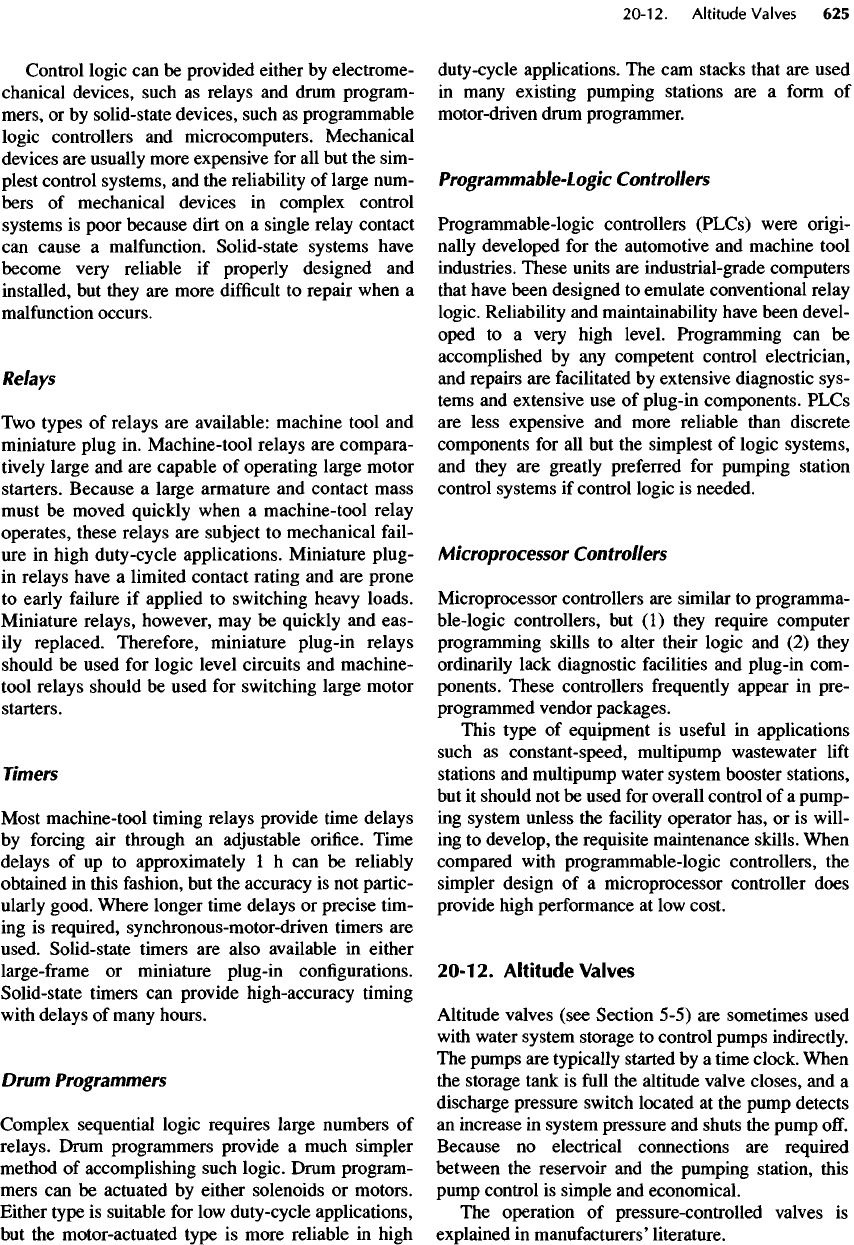
Control logic
can be
provided either
by
electrome-
chanical
devices, such
as
relays
and
drum program-
mers,
or by
solid-state devices, such
as
programmable
logic controllers
and
microcomputers. Mechanical
devices
are
usually more expensive
for all but the
sim-
plest control systems,
and the
reliability
of
large num-
bers
of
mechanical devices
in
complex control
systems
is
poor because dirt
on a
single relay contact
can
cause
a
malfunction.
Solid-state systems have
become very reliable
if
properly designed
and
installed,
but
they
are
more
difficult
to
repair when
a
malfunction
occurs.
Relays
Two
types
of
relays
are
available: machine tool
and
miniature
plug
in.
Machine-tool relays
are
compara-
tively
large
and are
capable
of
operating large motor
starters. Because
a
large armature
and
contact mass
must
be
moved quickly when
a
machine-tool relay
operates, these relays
are
subject
to
mechanical
fail-
ure in
high duty-cycle applications. Miniature plug-
in
relays have
a
limited contact rating
and are
prone
to
early failure
if
applied
to
switching heavy loads.
Miniature
relays, however,
may be
quickly
and
eas-
ily
replaced. Therefore, miniature plug-in relays
should
be
used
for
logic level circuits
and
machine-
tool relays should
be
used
for
switching large motor
starters.
Timers
Most machine-tool timing relays provide time delays
by
forcing
air
through
an
adjustable
orifice.
Time
delays
of up to
approximately
1 h can be
reliably
obtained
in
this
fashion,
but the
accuracy
is not
partic-
ularly
good. Where longer time delays
or
precise tim-
ing
is
required,
synchronous-motor-driven
timers
are
used. Solid-state timers
are
also available
in
either
large-frame
or
miniature plug-in configurations.
Solid-state timers
can
provide high-accuracy timing
with
delays
of
many hours.
Drum
Programmers
Complex
sequential logic requires large numbers
of
relays. Drum programmers provide
a
much simpler
method
of
accomplishing such logic. Drum program-
mers
can be
actuated
by
either solenoids
or
motors.
Either type
is
suitable
for low
duty-cycle applications,
but
the
motor-actuated type
is
more reliable
in
high
duty-cycle
applications.
The cam
stacks that
are
used
in
many existing pumping stations
are a
form
of
motor-driven drum programmer.
Programmable-Logic Controllers
Programmable-logic controllers (PLCs) were origi-
nally
developed
for the
automotive
and
machine tool
industries. These units
are
industrial-grade computers
that
have been designed
to
emulate conventional relay
logic.
Reliability
and
maintainability have been devel-
oped
to a
very high level. Programming
can be
accomplished
by any
competent control
electrician,
and
repairs
are
facilitated
by
extensive diagnostic sys-
tems
and
extensive
use of
plug-in components. PLCs
are
less expensive
and
more reliable than discrete
components
for all but the
simplest
of
logic systems,
and
they
are
greatly preferred
for
pumping station
control systems
if
control logic
is
needed.
Microprocessor Controllers
Microprocessor controllers
are
similar
to
programma-
ble-logic controllers,
but (1)
they require computer
programming skills
to
alter their logic
and (2)
they
ordinarily lack diagnostic facilities
and
plug-in com-
ponents. These controllers frequently appear
in
pre-
programmed vendor packages.
This type
of
equipment
is
useful
in
applications
such
as
constant-speed,
multipump
wastewater
lift
stations
and
multipump water system booster stations,
but
it
should
not be
used
for
overall control
of a
pump-
ing
system unless
the
facility
operator has,
or is
will-
ing
to
develop,
the
requisite maintenance
skills.
When
compared with programmable-logic
controllers,
the
simpler design
of a
microprocessor controller does
provide high performance
at low
cost.
20-12.
Altitude
Valves
Altitude valves (see Section 5-5)
are
sometimes used
with
water system storage
to
control pumps indirectly.
The
pumps
are
typically started
by a
time
clock.
When
the
storage tank
is
full
the
altitude valve
closes,
and a
discharge pressure switch located
at the
pump detects
an
increase
in
system pressure
and
shuts
the
pump off.
Because
no
electrical
connections
are
required
between
the
reservoir
and the
pumping station, this
pump
control
is
simple
and
economical.
The
operation
of
pressure-controlled valves
is
explained
in
manufacturers'
literature.
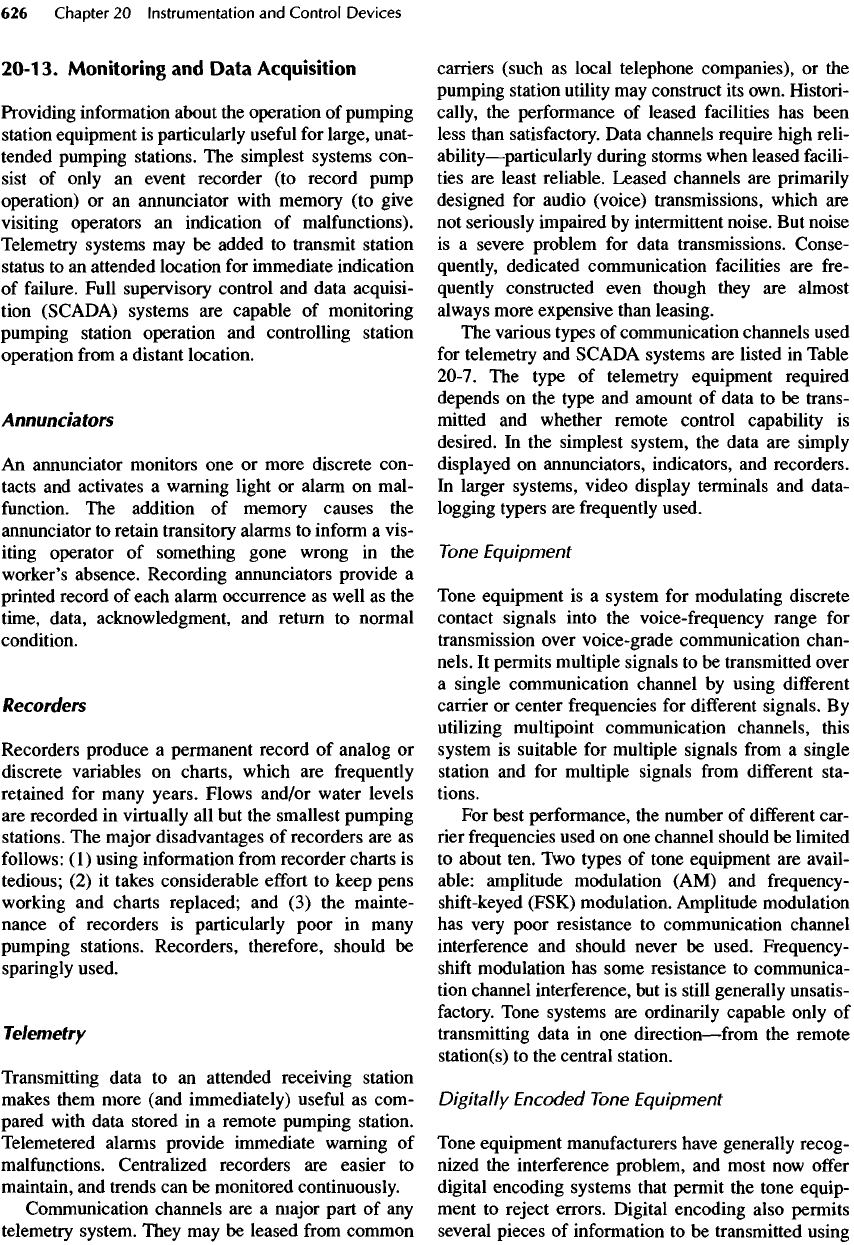
20-1
3.
Monitoring
and
Data
Acquisition
Providing information about
the
operation
of
pumping
station equipment
is
particularly
useful
for
large, unat-
tended pumping stations.
The
simplest systems con-
sist
of
only
an
event recorder
(to
record pump
operation)
or an
annunciator with memory
(to
give
visiting operators
an
indication
of
malfunctions).
Telemetry
systems
may be
added
to
transmit station
status
to an
attended location
for
immediate indication
of
failure.
Full supervisory control
and
data acquisi-
tion (SCADA) systems
are
capable
of
monitoring
pumping
station operation
and
controlling station
operation
from
a
distant location.
Annunciators
An
annunciator monitors
one or
more discrete con-
tacts
and
activates
a
warning light
or
alarm
on
mal-
function.
The
addition
of
memory causes
the
annunciator
to
retain transitory alarms
to
inform
a
vis-
iting operator
of
something gone wrong
in the
worker's absence. Recording annunciators provide
a
printed record
of
each alarm occurrence
as
well
as the
time,
data, acknowledgment,
and
return
to
normal
condition.
Recorders
Recorders produce
a
permanent
record
of
analog
or
discrete variables
on
charts, which
are
frequently
retained
for
many
years. Flows and/or water levels
are
recorded
in
virtually
all but the
smallest pumping
stations.
The
major
disadvantages
of
recorders
are as
follows:
(1)
using information
from
recorder charts
is
tedious;
(2) it
takes considerable
effort
to
keep pens
working
and
charts
replaced;
and (3) the
mainte-
nance
of
recorders
is
particularly poor
in
many
pumping
stations.
Recorders,
therefore, should
be
sparingly used.
Telemetry
Transmitting
data
to an
attended receiving station
makes
them more (and immediately)
useful
as
com-
pared with data stored
in a
remote pumping station.
Telemetered alarms provide immediate warning
of
malfunctions.
Centralized recorders
are
easier
to
maintain,
and
trends
can be
monitored continuously.
Communication
channels
are a
major
part
of any
telemetry system. They
may be
leased
from
common
carriers
(such
as
local
telephone
companies),
or the
pumping
station utility
may
construct
its
own. Histori-
cally,
the
performance
of
leased facilities
has
been
less than satisfactory. Data channels require high
reli-
ability
—
particularly
during storms when leased
facili-
ties
are
least reliable. Leased channels
are
primarily
designed
for
audio (voice) transmissions, which
are
not
seriously impaired
by
intermittent
noise.
But
noise
is
a
severe problem
for
data transmissions. Conse-
quently,
dedicated communication facilities
are
fre-
quently
constructed even though they
are
almost
always more expensive than leasing.
The
various types
of
communication channels used
for
telemetry
and
SCADA systems
are
listed
in
Table
20-7.
The
type
of
telemetry equipment required
depends
on the
type
and
amount
of
data
to be
trans-
mitted
and
whether remote control capability
is
desired.
In the
simplest system,
the
data
are
simply
displayed
on
annunciators, indicators,
and
recorders.
In
larger systems, video display terminals
and
data-
logging typers
are
frequently
used.
Tone
Equipment
Tone equipment
is a
system
for
modulating discrete
contact signals into
the
voice-frequency range
for
transmission over voice-grade communication chan-
nels.
It
permits multiple signals
to be
transmitted over
a
single communication channel
by
using
different
carrier
or
center
frequencies
for
different
signals.
By
utilizing multipoint communication channels, this
system
is
suitable
for
multiple signals
from
a
single
station
and for
multiple signals
from
different
sta-
tions.
For
best performance,
the
number
of
different
car-
rier
frequencies
used
on one
channel should
be
limited
to
about ten.
Two
types
of
tone equipment
are
avail-
able: amplitude modulation (AM)
and
frequency-
shift-keyed
(FSK) modulation. Amplitude modulation
has
very
poor
resistance
to
communication channel
interference
and
should never
be
used.
Frequency-
shift
modulation
has
some resistance
to
communica-
tion channel interference,
but is
still generally unsatis-
factory.
Tone systems
are
ordinarily capable only
of
transmitting data
in one
direction
—
from
the
remote
station(s)
to the
central station.
Digitally
Encoded
Tone
Equipment
Tone equipment manufacturers have generally
recog-
nized
the
interference problem,
and
most
now
offer
digital
encoding
systems that
permit
the
tone
equip-
ment
to
reject errors. Digital encoding also permits
several
pieces
of
information
to be
transmitted using
